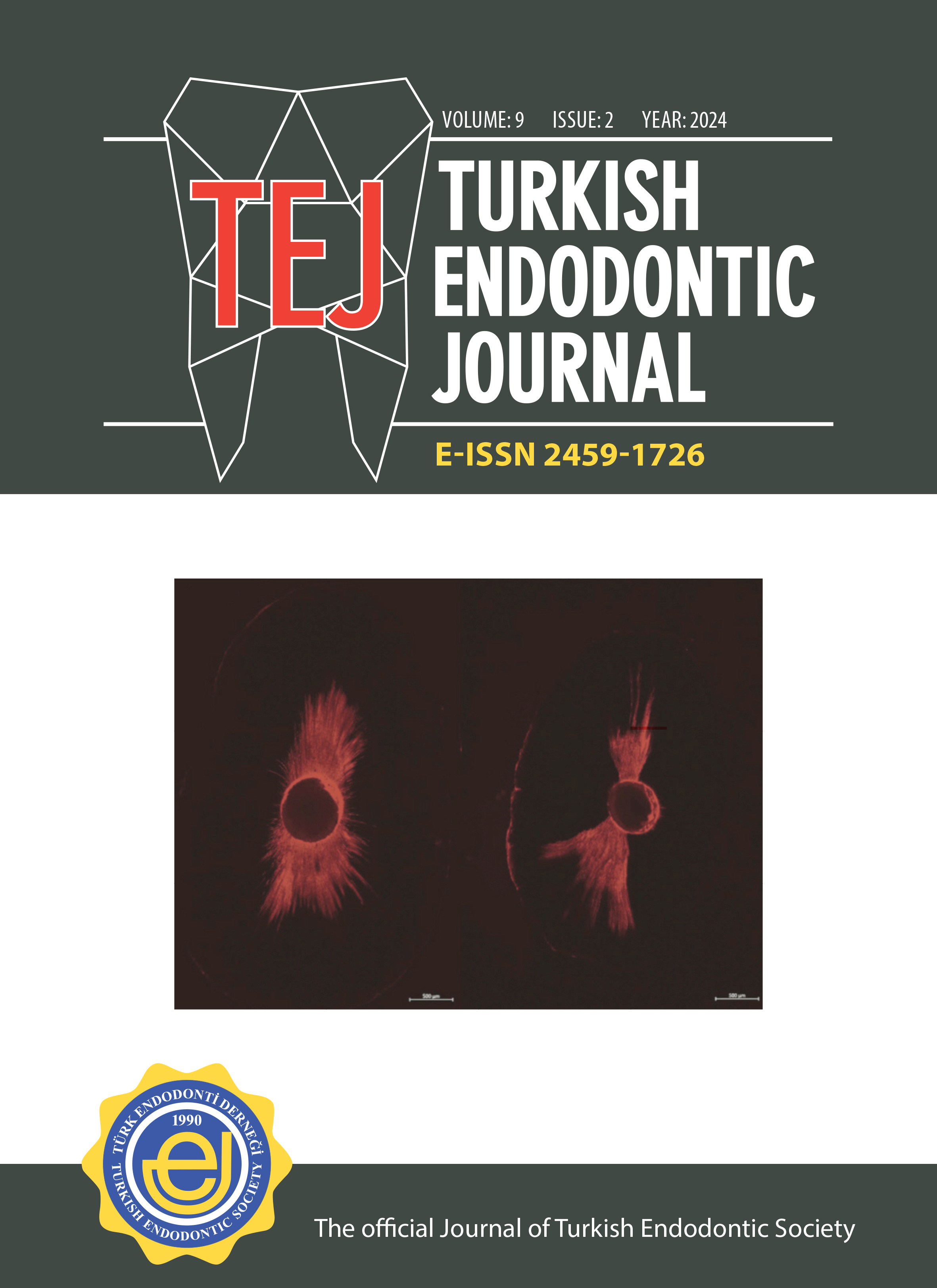Volume: 9 Issue: 2 - 2024
| 1. | Front Matter Pages I - VIII |
| ORIGINAL RESEARCH | |
| 2. | Evaluation of the frequency of dental anomalies in children: A cross-sectional retrospective study Büşra Karaağaç Eskibağlar, Yelda Polat, Şemsettin Yıldız, Gizem Karagöz Doğan doi: 10.14744/TEJ.2024.52724 Pages 71 - 76 Purpose: This study aimed to determine the prevalence of common dental anomalies in children. Methods: In this study, 5280 digital orthopantomographic images of patients aged 5-16 years were retrospectively analyzed. A total of 3619 digital orthopantomographic images that met the study criteria were evaluated. Descriptive statistics of the categorical data obtained were analyzed using percentage and frequency analyses, followed by Pearson Chi-Square or Fisher’s Exact test for binary group comparisons. The significance level for statistical analyses was set at (p < 0.05). Results: In the individuals included in the study, at least one dental anomaly was detected in 13.78%. Numerical anomalies were the most commonly observed type of anomaly, with hypodontia being the anomaly with the highest prevalence in this group. A statistically significant difference was observed between genders in the frequency of supernumerary teeth, ectopy, and mesiodens (p > 0.05). Conclusion: Dental anomalies can occur in different types in humans. Clinicians can prevent future dental problems that may occur in later ages with the early diagnosis and treatment of dental anomalies. |
| 3. | The perspectives of dental clinical students about the challenges of endodontic procedures Selin Göker Kamalı, Yaren Tuana Altınova, Betül Aycan Alim Uysal, Dilek Türkaydin, Hesna Sazak Öveçoğlu doi: 10.14744/TEJ.2024.22931 Pages 77 - 83 Purpose: To evaluate the opinions of dental clinic students regarding the challenges of endodontic therapy and compare their responses based on their academic years. Methods: A survey was prepared to evaluate the difficulties experienced by students regarding anesthesia, taking radiographs, use of rubber dam, cavity preparation, identifying radiographic apex, instrumentation, irrigation, intracanal medicament application, root canal filling, and temporary restoration procedures. The survey, consisting of 13 main questions (with yes/no answers) and 13 sub-questions (multiple choice), was responded to by 60 fourth-year and 60 fifth-year dentistry students. The Pearson Chi-Square and Fisher’s Exact tests were applied to evaluate the students’ answers according to their academic years. Results: Taking radiographs, determining the master cone, and filling the root canal were the most challenging endodontic procedures. There was a statistically significant difference between the responses of fourth- and fifth-year students to the main questions regarding root canal filling and access cavity preparation (p<0.05). Conclusion: During training, more emphasis should be placed on taking radiographs, identifying the master cone, and filling the root canals. Fifth-year students performing endodontic treatment of anatomically difficult cases were found to have less self-efficacy in filling root canals and preparing the endodontic access cavity. |
| 4. | Can activation of root canal sealer enhance the penetration into lateral canals? Öznur Sarıyılmaz, Evren Sarıyılmaz, Saadet Elpe doi: 10.14744/TEJ.2024.00710 Pages 84 - 89 Purpose: This study aimed to compare the efficacy of a resin-based canal sealer and a bioceramic canal sealer in obturating lateral canals, with and without the use of activation methods. Methods: Lateral canals were created at apical positions of 3, 5, and 8 mm in eighty 3D-printed maxillary central teeth. After root canal preparation, the teeth were embedded in 1.5% agar agar to simulate periodontal tissues. The teeth were divided into two main groups based on the type of root canal sealer and further categorized into four subgroups for activation methods: Conventional, EDDY, EndoActivator, and Passive Ultrasonic. Root canals were filled using the single cone technique, and images were captured at 17× magnification. Sealer penetration into lateral canals was measured using ImageJ software. Activation methods were compared using the Kruskal-Wallis test; root levels were compared using the Friedman test, and comparisons between sealers were made with the Mann-Whitney U test at a 95% confidence level. Results: Activation methods had no significant impact on sealer penetration for both types of sealers. In ultrasonic activation groups, the bioceramic sealer exhibited significantly higher penetration than the resin-based sealer at all root levels. In sonic activation groups, the bioceramic sealer showed significantly superior penetration, especially at the middle root level. Conclusion: Activation methods did not significantly alter sealer penetration into lateral canals. Bioceramic-based root canal sealer demonstrated enhanced penetration compared to resin-based sealer, especially with ultrasonic and sonic activation. |
| 5. | Evaluation of biomechanical properties of endodontic files with different pitch by finite element analysis Mehmet Eskibağlar, Serkan Erdem doi: 10.14744/TEJ.2024.78941 Pages 90 - 95 Purpose: The purpose of this study was to evaluate the stress distribution of endodontic nickel-titanium (Ni-Ti) rotary files with different pitches in bending and torsion tests using finite element analysis (FEA). Methods: Finite element models of superelastic Ni-Ti endodontic rotary instrument files with three different pitches (12, 15, and 18) were created using SolidWorks software. All endodontic files were modeled with the same length, apical diameter, and cross-sectional geometry. These models were transferred to ANSYS software for analysis. Tests to evaluate the flexibility and torsional stiffness of the files were performed using the FEA method, according to the ISO 3630-1 specification. The results obtained were calculated using the von Mises stress. Results: The stiffness and maximum stress decreased as the pitch value increased. According to the test results, the 18 pitch file system exhibited higher flexibility than the 12 pitch and 15 pitch file systems when subjected to bending. In terms of torsional resistance, the 12 pitch rotary file showed higher torsional resistance than the 15 pitch and 18 pitch endodontic files. Conclusion: Clinicians should be aware of the geometric differences in rotary files and use the appropriate file for clinical situations in addition to the manufacturer’s instructions. |
| 6. | Evaluation of the effect of Mozart’s music on stress, anxiety, and dexterity levels of dental students in preclinical endodontic training using a haptic virtual reality simulator Sıla Nur Usta, Eda Doğuş, Zeliha Uğur Aydın doi: 10.14744/TEJ.2024.97658 Pages 96 - 102 Purpose: To assess the stress and anxiety levels of 3rd-year students in preclinical training along with their success rates under the background of Mozart’s music using a haptic virtual reality simulator (HVRS). Methods: Sixty 3rd-year dentistry students enrolled in preclinical endodontic training were selected based on the inclusion criteria. Participating students were randomly divided into two groups according to whether Mozart’s music was used during the access cavity preparation using HVRS. Stress and anxiety levels were evaluated with the Stress-VAS 1 and 2 scales and STAI S and T questionnaires, respectively. Manual dexterity was measured based on the target progress, accuracy, target volume, and outside volume. Data were analyzed with Fisher’s exact and Mann-Whitney U tests and the square of the Spearman linear coefficient. Results: There was no statistically significant difference between genders regarding stress and anxiety levels (p > 0.05). Music significantly reduced stress and anxiety levels and enhanced manual dexterity (p < 0.05). A significant negative association was observed between the target progress and Stress-VAS 2 (p < 0.05), whereas the correlation did not differ between accuracy and Stress-VAS 2 (p > 0.05). Conclusion: Mozart’s music positively affected stress and anxiety levels along with the manual dexterity of students in preclinical endodontic training using HVRS. |
| 7. | A topographic analysis of the surface changes in reciprocating and rotary Ni-Ti instruments after multiple uses Gülsen Kiraz, Arzu Kaya Mumcu, Safa Kurnaz doi: 10.14744/TEJ.2024.38258 Pages 103 - 110 Purpose: This study aims to investigate the impact of repeated use within curved root canals on the surface characteristics of both reciprocating and rotary instruments, using Field Emission Scanning Electron Microscopy (FESEM) for detailed analysis. Methods: Curved acrylic blocks were randomly divided into two groups and were prepared using WaveOne Gold (WOG) and One Curve (OC) files. Both WOG and OC groups were further divided into subgroups: control, 1st use, 2nd use, 3rd use, and separated files. Following each use, the instruments underwent ultrasonic cleaning and sterilization procedures. These procedures continued until fracture occurred and changes in the surface characteristics of files were examined under FESEM. Descriptive data were reported for each group. Results: With increasing use within each group, the instruments exhibited a rise in the frequency of surface damage, including cracks, flattening, deterioration of cutting edges, microcavities, and debris accumulation. A fracture occurred in the OC file after the 8th use, while the WOG file fractured after the 6th use. Conclusion: Repeated use increased defects and deformations in both files. Based on the surface characteristics of both files, single-use applications of WOG and OC files are considered safer. |
| 8. | The comparative evaluation of temperature changes on the external root surface during the application of different obturation techniques Fatoş Albayrak, Recai Zan doi: 10.14744/TEJ.2024.38257 Pages 111 - 118 Purpose: The present research aimed to examine the possibility of damage to tooth support tissues induced by temperature changes on the external root surface while applying different obturation techniques. Methods: One hundred fifty mandibular premolar teeth were prepared using a ProTaper Next nickel-titanium rotary file system. After the preparation, the distance between the inner dentin and the external cementum was measured at nine points with cone-beam computed tomography. Then, 100 teeth with the closest dentin thickness were included in the study. The teeth were randomly divided into five groups: cold lateral condensation, warm vertical condensation, continuous-wave obturation, thermoplastic injection, and carrier-based obturation techniques. Temperature changes were measured from the external root surface with the degree of intraoral temperature while applying obturation techniques. Results: The warm vertical condensation technique caused the highest temperature increases statistically, and the lowest temperature increases were detected while applying the cold lateral condensation and carrier-based obturation techniques. Conclusion: Consequently, obturation techniques may be safely preferred in terms of temperature increases that may cause damage to supporting tissues. |


















